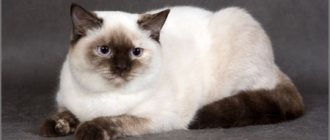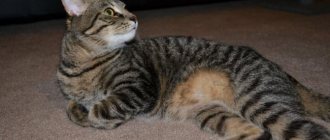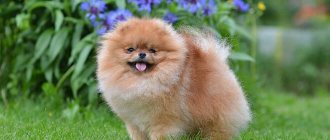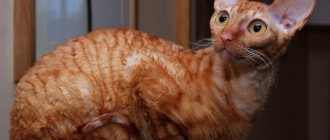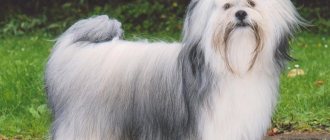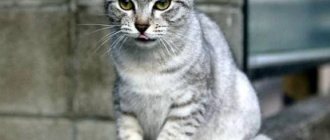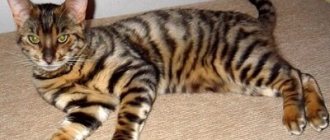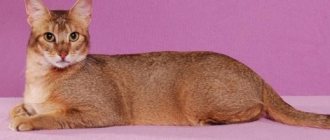Home » Breeds » About the Sokoke cat breed
Kenya is not only a republican state in East Africa, it is also a huge National Park, in the center of which rises the second highest stratovolcano mountain, after Kilimanjaro. The national park is called Mount Kenya.
Such forests are always an excellent refuge for numerous wild inhabitants, including buffalos and elephants, as well as many members of the Felis family - cats. There are large tiger cats Leopardus, there are mighty Profelis - lions, and there are also very small ones, such as the Kenyan forest cat - Kenya parva cattus or simply - sokoke, a little larger than the domestic cat we are used to. Sokoke-sokok – this is roughly what the name of this small Kenyan cat sounds like in Swahili.
Description of the breed
These exotic Kenyan cats have striking appearance. They have a flexible, slender body and long legs. The animals are medium in size, body weight reaches 3-5 kg. Like the wild cats of Africa, they have tufted ears, a black-tipped tail, and hypnotic large eyes that change color from amber to light green depending on their mood. Soukkas have an unusual gait, this is due to the difference in the length of the front and hind legs (the hind legs are longer than the front ones). The hairs lie tightly to the body. There is practically no undercoat. Color type: marbled tabby, may vary. The wild ancestors of the Sokoke rewarded her with excellent health. The only weak point is the nervous system of these cats. They are prone to nervous disorders. These diseases are inherited. Sometimes they occur as concomitants after a cat has suffered another illness. Otherwise, these cats are susceptible to the same diseases and injuries as ordinary ones.
Character of the breed
Kenyan cats took the character and behavior from their wild relatives: activity, endurance, courage, agility. The Sokoke pet is constantly moving, playing with its owner and pets, and hunting. Thanks to independence and independence, he finds interesting activities and is not burdened by short-term loneliness. Able to climb onto high furniture and descend with dexterity.
You cannot let your pet Sokoke out for a walk without a leash, even in the private sector. The cat will certainly climb a tree or run away to hunt.
The main character trait of the Sokoke breed is its strong attachment to a caring owner. The cat loves to lie down on her lap, does not skimp on affection, and loves to sit nearby and watch the work of the household. The absence of the owner for many days and moving to another family is a huge stress for the pet, causing nervous disorders. The Sokoke breed is characterized by talkativeness; the pet communicates with its owner in a loud but melodious voice.
An intelligent and understanding Sokoke cat responds to its name, understands what is allowed and prohibited to do, knows how to live according to the rules and routine of the family, and quickly learns to carry out simple commands. Training should take place calmly, with obligatory encouragement of the pet for correct actions.
The Kenyan cat's attitude towards dogs is either friendly or distant. There is no point in keeping hamsters, parrots, or other small animals: a Kenyan pet will certainly want to hunt. A family with children should not own the Sokoke breed. The cat does not like being squeezed, and if a naughty child decides to pull the cat's tail, he will be left with a scratched face.
Character
By nature, Sokoke cats are active, playful, curious and intelligent cats. Therefore, cats of this breed should be kept in a spacious private house with a large surrounding area. From wild cats they inherited an independent and proud disposition, but despite having wild ancestors, they are kind and easy-going animals, able to get along with all family members and other pets. These cats enjoy active games and enjoy swimming, jumping and running. They calmly endure short periods of loneliness; the absence of the owner of the house will not spoil their mood, because they can easily find something to do to their liking. A variety of toys will help them with this. Sokoke cats are affectionate and kind, but they do not require much attention to themselves; they will not beg for your affection, but will be happy to follow on your heels.
History of the breed
Until the 1980s, there was not the slightest information about Kenyan cats. One day, a resident of the Kenyan Sokoke district, Jenny Slater, noticed stray kittens with an unusual and beautiful color and decided to take them in.
The grown pets produced offspring, which Jenny showed to a friend who came from Denmark. A Danish woman brought kittens to Europe. Later, the cats bred by the second line were exported to the USA.
Sokoke cats are not completely wild. The genotype indicates a relationship with cats of the Lamu Archipelago and domestic pets living in the eastern cities of Kenya.
Care
Despite their exotic appearance, Sokoke cats need to be cared for in almost the same way as a regular cat. It is enough to comb the coat once a week and bathe it once a month with a special shampoo for cats. Sokoke love water, so cleaning procedures will be easy. When combing, you should use a brush made of natural bristles, and to give the coat additional shine, you can wipe the fur of this beautiful cat with a piece of natural suede, fur or silk. To maintain and strengthen the health of the soukoke, it is necessary to regularly conduct examinations with a veterinarian, vaccinate, and deworm the animal.
Appearance
Photo: Soukok (Kenyan forest cat)
Soukoki is medium sized, slightly lean, but not painfully thin. They look fit and strong. They are also sometimes called miniature cheetahs. The head of these cats looks small in proportion to the body. It has a wedge shape, but with rounded, not sharp outlines. Cheekbones are high and strong, a strong chin. Soukoks have a straight, wide nose, and the nose should be painted a bright brick color. The ears are large, wide, with rounded tips. According to the standard, they should be placed high and wide. Tassels on the tips of the ears are desirable, but not required. The eyes are large and very beautiful almond-shaped. Eye color varies from yellowish to bright green. The neck of Kenyan cats is surprisingly short and wide, muscular and mobile. The chest is powerful, the skeleton does not seem fragile, but on the contrary, it is well developed and looks strong. Long slender limbs indicate a good jumper and predator. The hind legs are slightly longer than the front legs, which makes the cat seem to move in a semi-squat position. The paws are small and the paw pads should be black according to the standard. The tail of representatives of this breed is of medium length, tapering towards the tip. The coat is very short, lies close to the body, may seem harsh, but is very soft to the touch. The color is absolutely amazing. Black or brown tabby with merle, spots should be in the form of rosettes, light ticking on the sides of the body is acceptable.
Recommended Diet
If you want to not only pamper your beloved cat with a delicious treat, but also ensure her excellent health, active life and daily tone, then it’s hard to come up with something better than Sanabelle special food. Sanabelle dry cat food contains only natural ingredients, selected fresh meat, and no food dyes. No product contains soy, corn or GMOs. Such food will be a real gift for your furry pet and the best evidence of a caring attitude towards him and tender feelings.
Sanabelle Kitten with birdFor kittens, pregnant women andnursing cats | Sanabelle Adult with birdFor adult cats | Sanabelle SterilizedFor sterilized cats |
Features of behavior and character
This breed has an active life in their blood, it is passed on to them through their genes. Sokoke's character is very playful and restless. Cats of this breed are distinguished by high intelligence; they are also very smart. But in their genes they not only have an active lifestyle, but also a strong-willed, strong and independent character.
Along with this, Sokoke become strongly attached to their owner, expressing their love through playfulness. They very quickly establish contact with visitors, whether human or animal (they get along with other cats and some breeds of dogs).
In a family, the cat behaves quite affectionately and gently, which cannot but please the owners, however, all representatives of the breed have an unstable nervous system, so you need to behave with them just as affectionately and calmly.
Representatives of the breed are special for their endurance and energy, because they constantly jump in trees, run, climb in different corners of the house, and can swim well. All this is hereditary.
Sokoke cats adapt well to apartment living conditions, but the best option for them would be a house with a large yard. You can create a whole jungle in your yard, where the cat will feel at ease.
He will have plenty of space where he can throw out all his energy (preferably with high fences). This is an excellent solution, because then all your home furniture will remain safe.
Owners and their guests have nothing to fear from aggressive behavior from their pet, but problems can arise due to poor nutrition. Representatives of the breed do quite well in solitude while their owners are working.
He does not crave special attention, but at the end of the day he usually greets his owner after work with great love. The main task of a person is to provide the cat with a wide space for its leisure.
Unlike many breeds, Sokoke are not used to begging for something from their owners with their meows, or staying at their feet for a long time. They are charged with energy for the whole day. Cats of this breed can easily keep a person company during his walks. In some situations, they show their fearless nature and determination.
Cats get along well with children, they do not show aggression, and often allow them to play with them. Their fear may be caused by children's screams and pranks.
Catering
Sokoke can be fed both natural and ready-made food. But it’s better to make a choice as soon as the baby comes into your home, and in the future the diet should be changed only if absolutely necessary. The cat's stomach, having become accustomed to one type of food, may react painfully to such changes.
The cat's menu should be balanced: contain sufficient amounts of fats, carbohydrates, proteins, as well as minerals and vitamins.
Natural food requires standing at the stove every day and running around shops and markets, but you will know for sure that the food is fresh and pamper your pet with one dish or another.
Natural products
- Sources of protein: meat (veal, chicken, beef, turkey, lamb), offal (liver, kidneys, ventricles, hearts), fish (salmon, flounder, trout, navaga), chicken and quail eggs, dairy products (ryazhenka, kefir , cottage cheese, yogurt).
- Sources of fats: vegetable oils (olive, sunflower, flaxseed), chicken yolk, fish oil, offal.
- Sources of carbohydrates: porridge (rice, oatmeal, buckwheat, corn, wheat), boiled or raw vegetables (pumpkin, carrots, green beans, asparagus, broccoli, zucchini, cauliflower).
The amount of food depends on the age, condition of the breed and the general physical condition of the animal. Cats older than one year are fed 2 times a day: morning and evening. Adolescents from 6 months to six months - 3 times. Under 6 months - 4-6 times.
Recommended food
When choosing ready-made food, carefully read the reviews of the owners, the recommendations of veterinarians and the labels on the packages. Don’t believe advertising slogans and bright pictures: there is not much quality food available. First of all, these include food from the holistic group. These foods are made from high-quality products; they contain plenty of meat, vegetables and healthy additives, and there are no harmful components at all. But holistic foods are also expensive.
Super-premium foods are a step below holistic foods, and they are somewhat lower in quality. Firstly, the percentage of meat is not indicated, and secondly, corn and wheat are sometimes used (which can cause allergies).
Premium and economy food are even worse. Wheat and corn are used there all the time; instead of meat, remnants of the human food industry are added (this can be leather or ground bones).
Holistic food: Applaws, Carnilove, Orijen, Power of Nature. Super premium food: Brit Care, Summit, Vet Life.
Below are recommended super-premium foods. Links with the names of the food are clickable, on them you can, within our website, get acquainted with the descriptions of the food and read reviews from owners of Sokoke cats.
| Holistic | Super premium | Super premium |
| Wellnes | Duke's Farm | Dr Clauder's |
In addition to simple food, the cat must be given a good vitamin and mineral supplement, as well as sprouting grass to cleanse the stomach of hair. This is not a blessing, but a necessity: wool forms lumps in the stomach, which causes discomfort and a direct path to diseases of the gastrointestinal tract. Fresh grass helps get rid of them.
Sokoke health
Nature created the Sokoke ancestors in the wild jungle. Therefore, initially all the descendants of the breed were not accustomed to low temperatures. In addition, if a cat catches a slight cold, you should immediately contact a veterinarian - Sokoke cats are not accustomed to diseases and infections of northern countries.
It must be said that cats are sometimes prone to nervous system disorders. You can observe the animal’s strong whims, neuroses and even hysterics. In the most serious cases of distress, the cat may collapse in convulsions.
Therefore, it is recommended to keep Sokoke at home without taking it outside. If your pet exhibits nervous disorders, you should show it to a veterinarian and strictly follow all recommendations of a care specialist.
On average, Sokoke cats live 15 years. If you properly care for your pet, its old age will pass without serious illnesses or complications. No hereditary diseases have been found in the breed.
The breed has excellent health, so the owner does not have any special problems even if the cat has a cold.
How to choose the right Sokoke pet
Wanting to purchase a domesticated Kenyan cat, many connoisseurs of primitive beauty want to save money. It is worth knowing that purebred Sokoke are sold today only in breeding clubs or from serious breeders, so they certainly cannot be cheap. The average price for a kitten is approximately 60 thousand rubles. There are often cases when Sokoke are sold for 100 thousand rubles - you need to take into account that the breed is rare.
The final cost of the animal is influenced by three factors:
- pedigree;
- compliance;
- Country of Residence.
When choosing a Sokoke kitten, you should inquire in advance about the pedigree of the parents. The animal must be sold either with a passport or with a certificate, on the basis of which the new owner will independently create a passport.
A small kitten has weakly expressed signs of its breed, so it is very easy for an inexperienced novice breeder to fall for the tricks of scammers. It is important to know that kittens begin to be sold at the age of 13 weeks, when they are already completely independent. In kittens, the tip of the tail, the tips of the ears and the stripes on the paws should be slightly darker than the other patterns on the skin. Regardless of color, the eye color should not be blue, otherwise it is not a purebred Sokoke.
History, character and description of the Sokoke or Soukok breed
The natural habitat of soukok is the Kenyan forest. This is where the story of the forest beauty begins. The local Giriama tribe captured cats for food. Thus, the aborigines managed to keep livestock intact - a sign of wealth and prosperity. Modern representatives of the cat tribe are not considered food. The breed originated and further developed naturally, without human intervention. Characteristic features were honed by nature. Any shortcomings were eliminated not by breeders, but by natural selection.
Photo of the cat Sokoke:
Today, the Soukok breed living in the wild is on the verge of extinction. Preservation of a unique variety of the cat family cannot be accomplished without the participation of people. The price of a Sokoke cat can reach $2000. The Sokoke lived in the African forest near Kenya and were not noticed by humans until 1978. The breed became famous thanks to the breeder Zhenya Slayter. The artist noticed newborn animals in her garden. The lady found the kittens with big ears, huge eyes and an unusual pattern interesting, and she took a couple of individuals from the wild cat’s litter for herself. Zhenya raised cats, surrounding them with care and attention. But as they grew older, she realized that they were very different from ordinary pets. A little later, the breeder's friend, Gloria Moeldrup, imported several kittens to Denmark. Sokoke were presented to the public at an exhibition in Copenhagen in 1983. It was then that they received their second name “African Shorthair cat”. A little later we managed to get our first litter. Since 1985, a long journey of recognition of the breed begins. In 1990, Gloria brought three more kittens from the Kenyan forest, who became the founders of today's kittens. After 4 years, felinologists carried out a detailed description of the breed, and the cats were given the official name “sokoke” or “soukok”. In the mid-nineties of the last century, the variety was officially recognized by the FIFe organization, and gradually other organizations began to approve forest individuals. Possessing elegance, grace and the manners of a predator, Sokoke are able to captivate the gaze of any person. It is no secret that they are often compared to wild animals - after all, in the photo, the soukok cat is incredibly similar to a cheetah or ocelot on a reduced scale. Forest beauties are quite strong and muscular. Thanks to the short coat and missing undercoat, the stately body and smooth curves of the animal are clearly visible. The protruding shoulder blades give the sokoke a special gracefulness.
Photos of Sokoke kittens:
Description of the forest beauties breed has the following characteristics: The cat’s slender body is elongated. The neck is long and thin. The head is small and wedge-shaped. Compared to the elongated body, the skull appears miniature. The cheekbones are well defined, the chin is sharp and strong. The nose is moderate, a small dimple on the bridge of the nose is almost invisible. Almond-shaped eyes are large. The color of the iris is bright green or amber. Ears are straight and large. They are set quite high and are at a decent distance from each other. On the pointed tips you can see the characteristic tassels that wild representatives of the cat family can boast of. The limbs are thin and long. The hind ones are slightly longer than the front ones. The paws are curled into a small soft ball. The gait is smooth and insinuating. The coat is thick, dense and very short. The main color of Sokoke cats is cream or light brown. Dark stripes are applied to a light background, which help the cat camouflage among the trees, making it invisible against the background of trunks and leaves.
Photos of Sokoke cats:
OLYMPUS DIGITAL CAMERA
Sokoke are affectionate, tireless and extremely inquisitive individuals. Kittens can explore their surroundings all day long, constantly surprising people with their thirst for knowledge and adventure. Despite their wild appearance, Kenyan beauties have a soft and quite friendly character. Forest cats are not inherently evil. Therefore, they easily get along in families where there are other full-fledged pets or small children. However, Sokoke's love does not extend to small rodents or other small animals. If the house where the forest cat lives has an aquarium with fish or a cage with hamsters, you should take care of their safety.
Individual weight
The size of the breed is average. Sokoke cats weigh no more than 5 kg. The weight of females is even less - in the range of 2.5-3 kg.
Health
Soukoks do not have a developed fat layer - after all, the cat is of African origin. Any draft or low temperature can cause serious illness. If you need to take your pet outside in the cool season, you need to dress the animal in warm overalls. The owner may have some difficulties regarding the health of the forest cat. This unique animal must be protected from contact with local cats, since diseases of yard cats are not inherent in Sokoke. Her body is not ready to resist unfamiliar viruses.
Contents and specifics of care
Each cat breed has its own maintenance nuances. It must be said that Sokoke do not require any specific care, so they are suitable for keeping for any “cat lover”.
Nutrition
Proper nutrition for Sokoke is the key to its energy and good mood. Therefore, breeders often combine both premium feed and natural food. There is an opinion that dry or wet cat food will be enough for cats of this breed, but this is not the case. Being a direct descendant of the Kenyan wild cat, the Sokoke needs natural food, which should make up approximately 50% of its daily diet. At first, it is better to feed your pet natural food, gradually accustoming it to standard cat food.
Veterinarians recommend feeding Sokoke with food from the following manufacturers:
- Royal Canin (Feline Health Nutrition series);
- Perfect Fit (series “5 components of health”);
- Hills (Nature Best series).
The manufacturer separates food for sterilized and unsterilized animals, so it is important to select food taking into account the properties of your pet
Natural food should include lean meat (chicken or beef), as well as sea fish. It is prohibited to give sokoke the following products:
- boiled or fried potatoes;
- fat meat;
- milk and cottage cheese;
- sweets;
- river fish with bones;
- smoked products.
Adult animals are usually fed twice - morning and evening. The serving size is determined by the weight of the animal - as a rule, for a cat weighing 5 kilograms per day, you need to eat 200-250 g of food. The calculation is carried out taking into account the daily food needs of tailed pets: 40 g of food per 1 kg of body.
Breeders note that Sokoke needs additional vitamins for cats. For proper functioning of the cardiovascular system and digestive organs, you need to add taurine and vitamins E to your food.
However, due to the active lifestyle of Sokoke, this norm may be slightly increased - up to 10–15%.
Kittens and pregnant and lactating cats need more frequent feeding. As a rule, they are fed 4-5 times a day in small portions.
Necessary living conditions
Sokoke do not like the street and extraneous noise. These are exclusively domestic cats. However, in order for them to live comfortably, some conditions will need to be created:
- spacious apartment;
- scratching post;
- houses and ladders for cats;
- a wide range of different toys.
Cats are very active and playful, so they need spaces for their play and a variety of different objects.
In fact, photographing a sokoke is not easy, since the animal is constantly on the move.
Hygiene and care
As such, caring for a cat comes down to three steps:
- wool washing;
- ear cleaning;
- eye cleaning;
- claw care.
Suitable grooming products
It can be said that Sokoke cats require virtually no grooming. They have very short fur that rarely sheds. Therefore, it is enough to simply comb the cat thoroughly once a week to remove excess hair.
Most representatives of this breed love to swim. Therefore, once every two to three months, professional breeders recommend bathing your cat using special shampoos for short-haired cats:
- — “Gentle” shampoo for soft fur;
- — Perfect Coat Studio product, makes the coat silkier and more pleasant to the touch;
- - anti-matt shampoo;
- — disinfecting shampoo for the prevention of parasites;
- — hygienic shampoo for cats.
Universal shampoo for softness and cleanliness of cat fur from domestic
How to properly clean your ears
Sokoke ears are cleaned once a week. To do this, a cotton swab with a limiter (so as not to damage the cat’s eardrums) is moistened with water or a special disinfecting lotion. The American drug EAR-CARE is perfect for these purposes.
Cleaning is carried out by gently pressing the stick on the inner surface of the ears. It is necessary to use several sticks until all dirt is removed from the auricle.
In general, it’s better to do without funds…. as a last resort, you can use a little soda solution and a cotton swab! and if you suspect something serious, then run to the doctor, do not look for advice from incompetent authorities on such issues!
Toyota
https://otvet.mail.ru/question/14404940
Cleaning your cat's eyes
Sokoke handle hygiene procedures themselves. Cleaning your cat's eyes is necessary if your cat's eyes are watery due to a cold.
Routine care is carried out with a weak chamomile decoction or tea leaves, which are applied to a cotton pad. You need to wipe the cat's eyes until the surface of the disc becomes clean.
Not all cats can tolerate eye rubbing, so it will take a lot of patience to get your pet used to this procedure.
In normal life, a Sokoke cat does not need eye cleaning.
Nail care
Like a descendant of the wild Kenyan cat, the sokoke, once in the house of a new owner, can begin to mark its territory - that is, scratch the furniture. To avoid this problem with a cat, be sure to install a scratching post for the animal from the first days. The surface of the scratching post should not be very shaggy: the best coating option is the texture of the underside of a carpet or tree bark.
However, this measure is not enough to permanently wean the cat from damaging furniture. Nail care (namely trimming) is a simple procedure that is accessible even to a beginner. About once every two weeks you need to trim the animal’s claws with a special tool. Typically, nail clippers are used for these purposes.
It is necessary to calm the cat so that it does not worry, since the procedure of trimming its claws is not the most pleasant for the pet. It is important to correctly determine the boundaries along which the claw will be cut. The claws contain blood vessels that do not need to be damaged, so the very tip of the claw is cut off.
The tool must be well sharpened, since the quality of claw care depends on this factor
